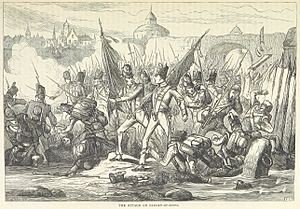91st (Argyllshire Highlanders) Regiment of Foot facts for kids
Quick facts for kids 91st Regiment of Foot |
|
|---|---|
| Active | 1794–1881 |
| Country | |
| Branch | |
| Type | Line Infantry |
| Size | One battalion (two battalions 1804–1815) |
| Motto(s) | Ne Obliviscaris (Do not forget) |
| Engagements | French Revolutionary Wars Napoleonic Wars |
The 91st (Argyllshire Highlanders) Regiment of Foot was a special group of soldiers in the British Army. They were formed in 1794. This regiment was known as a "Line Regiment," which means they fought in lines on the battlefield.
Later, in 1881, the 91st Regiment joined with another group, the 93rd (Sutherland Highlanders) Regiment of Foot. This happened because of new army rules called the Childers Reforms. Together, they became a new, bigger regiment called the Argyll and Sutherland Highlanders.
Contents
History
How the Regiment Started
The 91st Regiment began in a place called Argyll in Scotland. It was started by General Duncan Campbell in February 1794. He created it to help protect Britain from the French Revolution.
At first, it was called the 98th Regiment. In June 1795, these soldiers helped invade the Cape Colony (now part of South Africa). They saw the Dutch army surrender the colony in September 1795. In May 1796, the regiment's name changed to the 91st (Argyllshire Highlanders) Regiment of Foot. They returned to England in January 1803.
Fighting in the Napoleonic Wars

In August 1804, a second group of soldiers, called the 2nd Battalion, was formed in Perth. The 1st Battalion went to Germany in December 1805. They came back to England in February 1806.
In June 1808, the 1st Battalion sailed to Portugal to fight in the Peninsular War. They fought in important battles like the Battle of Roliça and the Battle of Vimeiro in August 1808. They also fought at the Battle of Corunna in January 1809. After this battle, they had to leave the Peninsula.
In April 1809, the regiment's name was shortened to just the 91st Regiment of Foot. The 1st Battalion then took part in the difficult Walcheren Campaign in late 1809.
The 1st Battalion returned to the Peninsula in September 1812. They fought in many more battles, including the Battle of Vitoria in June 1813 and the Battle of Sorauren in July 1813. They chased the French army into France. There, they fought in the Battle of the Nive in November 1813, the Battle of Nivelle in December 1813, and the Battle of Orthez in February 1814. Their last big battle in this war was the Battle of Toulouse in April 1814.
In April 1815, the 1st Battalion went to Ostend. They had an important job during the Battle of Waterloo in June 1815. They protected the road to Brussels. They also helped attack the fortress town of Cambrai later that month. The battalion returned to England in November 1818.
Meanwhile, the 2nd Battalion went to Germany in July 1813. They took part in an attack on Bergen op Zoom in March 1814, which was not successful. They came home in September 1814 and were officially ended in December 1815.
The Victorian Era
In November 1820, the regiment got its old name back: the 91st (or Argyllshire) Regiment of Foot. They went to the West Indies in June 1821 and stayed in Jamaica until 1831.
Some soldiers went to Saint Helena in November 1835. Most of them then sailed to South Africa in June 1839. One small group stayed in Saint Helena. Their job was to dig up the body of the famous Emperor Napoleon and take it to Paris.
In April 1842, the regiment formed a reserve battalion. The 1st Battalion fought in the 7th Xhosa War in 1846. They left South Africa in January 1848. The Reserve Battalion also fought in the 7th Xhosa War. Then, they fought against the Boers at the Battle of Boomplaats in August 1848. They also fought in the 8th Xhosa War in 1850. The Reserve Battalion left South Africa in July 1855 and was officially ended in March 1857.
The 1st Battalion went to Malta in December 1854, then to Greece in February 1855, and the Ionian Islands in February 1857. In September 1858, they traveled to Alexandria and then overland to India. They went to help stop the Indian Rebellion.
In May 1864, the regiment was renamed the 91st (the Argyllshire Highlanders) Regiment of Foot. They returned to England in October 1868. In March 1871, Princess Louise married John Campbell. The regiment formed a guard of honor at their wedding. Because of this, they were renamed the 91st (Princess Louise's Argyllshire Highlanders) Regiment of Foot in August 1872.
In February 1879, they went to South Africa to fight in the Anglo-Zulu war. They fought at the Battle of Gingindlovu in April 1879. They also helped end the Siege of Eshowe later that month.
In the 1870s, new army rules called the Cardwell Reforms linked regiments together. The 91st was linked with the 72nd Regiment, Duke of Albany's Own Highlanders. They shared a training base in Stirling Castle. On July 1, 1881, the Childers Reforms came into effect. The 91st Regiment joined with the 93rd (Sutherland Highlanders) Regiment of Foot to form the Argyll and Sutherland Highlanders.
Battle Honours
Battle honours are special awards given to regiments for their bravery in battles. Here are some of the battles the 91st Regiment was honored for:
Sources



